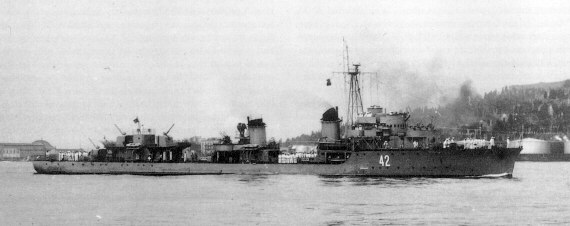- Yes
- No
About this class and its interest in War Thunder
Among the ships of the French navy cancelled following the battle of France in 1940, there is a class of destroyers little known but quite real. The construction of the Le Fier destroyers had begun and was well underway when it was halted. Moreover, there is a class of Spanish destroyers which used the original French plans and give a good overview of what the ship could be. Overall, its good performance could make an interesting ship for the future French navy in War Thunder.
History :
The Le Fier class was born from the problems raised by what was supposed to be an all purpose, escort/coastal patrol torpedo boat class, La Melpomène. Indeed, these sailed poorly in high and rough sea, and although their speed allowed it to escort convoy, their feeble weight put it at a disadvantage compared to other destroyers used for the same purpose, not to mention the lacking armament. It was thus decided in 1937 to launch a new program for bigger destroyers, with a better armament and capable of escorting fleets. It was called the Le Fier class. Their most distinctive feature was their artillery, 100mm twin turrets, which were located at the aft of the ship.
Work on these ship began in 1940. 24 ships of this class would have been created, however, the defeat of 1940 cancelled most of them. The three remaining unfinished warships were captured by the Kriegsmarine, which ordered the French workers to finish its construction. These workers did everything in their power to delay the launch of the ships, often sabotaging their own work so that the German navy could not access it. In the end, the unfinished hull were destroyed in 1944 during the Liberation of France.
The Spanish navy used the same plans captured and modified by the German navy to create the Audaz class, which was used by the Spanish navy until the 1970’s.
Specifications :
DIMENSIONS
Total length : 95m
Total width : 9.40m
draught : 3.40m
weight : 1350t max
ENGINE :
type : 3 x Indret boilers, and Rateau-Bretagne turbines (30 300 HP)
propellers : 2
max speed : 33 knots (61.2 km/h)
autonomy : 2000 miles at 20 knts
ARMAMENT (planned):
Original :
4 x 100mm mle 1933 (2 x 2)
4 x 37mm mle 1933 AA canons (4 x 1)
8 x 13.2mm Hotchkiss mgs (4 x 2)
4 x 550mm TLT (2 x 2)
CREW : 137 men
About the 100mm mle 1937 turrets :
These turrets designed for the future Richelieu battleships Gascogne and Clémenceau were far better designed than the previously used turrets, and allowed the 100mm canons to reach 16 rpm each.
Photos :
Plans :
Photos of the unfinished and destroyed hulls :
Photos of the Spanish Audaz class based on the same plans :
SOURCES :
Spoiler
Primary :
SAIBÈNE MARC, Les torpilleurs légers français, 1937 - 1945, Marine édition
Secondary :
Marine : les projets français qui ne furent jamais concrétisés
http://encyclopedie.das-boot.fr/encyclo_navire_fiche.php?nationalite=france libre&type=surface&formation=militaire&classe=Torpilleur classe Le Fier









